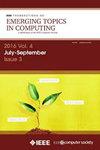Guest Editorial: IEEE Transactions on Emerging Topics in Computing Thematic Section on Memory- Centric Designs: Processing-in-Memory, In-Memory Computing, and Near-Memory Computing for Real-World Applications
IF 5.1
2区 计算机科学
Q1 COMPUTER SCIENCE, INFORMATION SYSTEMS
IEEE Transactions on Emerging Topics in Computing
Pub Date : 2023-06-06
DOI:10.1109/TETC.2023.3267909
引用次数: 0
Abstract
The von Neumann architecture has been the status quo since the dawn of modern computing. Computers built on the von Neumann architecture are composed of an intelligent master processor (e.g., CPU) and dumb memory/storage devices incapable of computation (e.g., memory and disk). However, the skyrocketing data volume in modern computing is calling such status quo into question. The excessive amounts of data movement between processor and memory/storage in more and more real-world applications (e.g., machine learning and AI applications) have made the processor-centric design a severe power and performance bottleneck. The diminishing Moore's Law also raises the need for a memory-centric design, which is rising on top of the recent material advancement and manufacturing innovation to open a paradigm shift. By doing computation right inside or near the memory, the memory-centric design promises massive throughput and energy savings.客座编辑:IEEE计算新兴主题汇刊以内存为中心的设计主题部分:内存处理、内存计算和近内存计算在现实世界中的应用
冯·诺依曼体系结构自现代计算诞生以来一直是现状。基于冯·诺依曼体系结构构建的计算机由智能主处理器(如CPU)和无法计算的哑存储器/存储设备(如存储器和磁盘)组成。然而,现代计算中飞速增长的数据量使这种现状受到质疑。在越来越多的现实世界应用程序(如机器学习和人工智能应用程序)中,处理器和内存/存储之间的数据移动量过大,这使得以处理器为中心的设计成为严重的功率和性能瓶颈。摩尔定律的减弱也引发了对以记忆为中心的设计的需求,这种设计是在最近的材料进步和制造创新之上兴起的,以开启范式转变。通过在内存内部或附近进行计算,以内存为中心的设计保证了巨大的吞吐量和能源节约。
本文章由计算机程序翻译,如有差异,请以英文原文为准。
求助全文
约1分钟内获得全文
求助全文
来源期刊

IEEE Transactions on Emerging Topics in Computing
Computer Science-Computer Science (miscellaneous)
CiteScore
12.10
自引率
5.10%
发文量
113
期刊介绍:
IEEE Transactions on Emerging Topics in Computing publishes papers on emerging aspects of computer science, computing technology, and computing applications not currently covered by other IEEE Computer Society Transactions. Some examples of emerging topics in computing include: IT for Green, Synthetic and organic computing structures and systems, Advanced analytics, Social/occupational computing, Location-based/client computer systems, Morphic computer design, Electronic game systems, & Health-care IT.
 求助内容:
求助内容: 应助结果提醒方式:
应助结果提醒方式:


